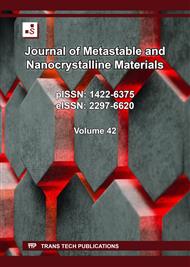p.1
p.9
p.27
p.35
p.45
p.57
p.67
Effect of Doping Potassium, Manganese and Cobalt on Zinc Oxide Nanoparticles Crystalline Properties
Abstract:
Zinc oxide has taken over modern studies for its suitability for the electronics, sensors, and optical devices industries related to its structural, optical, and electrical properties. This study tries to improve the properties of zinc oxide by doping it with some materials with distinctive properties to add their properties to zinc oxide. So, potassium has been used for its electrical properties, manganese for its high stability, and cobalt for its optical properties. Experiments were done in the same conditions using the chemical weight sol-gel synthesis method. making Zn0.96 X 0.04O (X = K, Mn, and Co) nanoparticles (NPs). Then, checked how their growth changed the structure of zinc oxide. Using XRD to fix structure and be sure that the doped X completely dissolved in ZnO without changing the structure of the wurtzite. The diffraction patterns demonstrated that all ZnO nanoparticles had hexagonal wurtzite structures and no impurity phase. The crystal sizes using the Scherrer formula are 19.48 nm for pure ZnO, 27.49 nm for Zn0.96 K0.04 O, 24.6 nm for Zn0.96 Mn0.04 O, and 44 nm for Zn0.96 Co 0.04 O. The SEM image shows hexagonal wurtzite structure with particles 32 nm in size for pure ZnO and 28, 34, and 54 nm in size for Zn0.96 X 0.04O, where X = K, Mn, and Co, respectively. The intensity of the Raman spectrum goes down for all X values of Zn0.96 X 0.04O (X = K, Mn, and Co), and the E2H peak is found between 430 and 450 cm-1. The peak intensities get weaker with Mn and Co doping and stronger with K doping. However, the positions of the peaks move slightly when doping, which suggests that the K, Mn, and Co added to ZnO don't change the hexagonal wurtzite structure. This fits well with the XRD patterns that were seen. Rather, it can control the size of the crystal according to the purpose of its use, whether electrical, optical, or for manufacturing sensors.
Info:
Periodical:
Pages:
1-7
Citation:
Online since:
November 2025
Authors:
Price:
Сopyright:
© 2025 Trans Tech Publications Ltd. All Rights Reserved
Share:
Citation:


